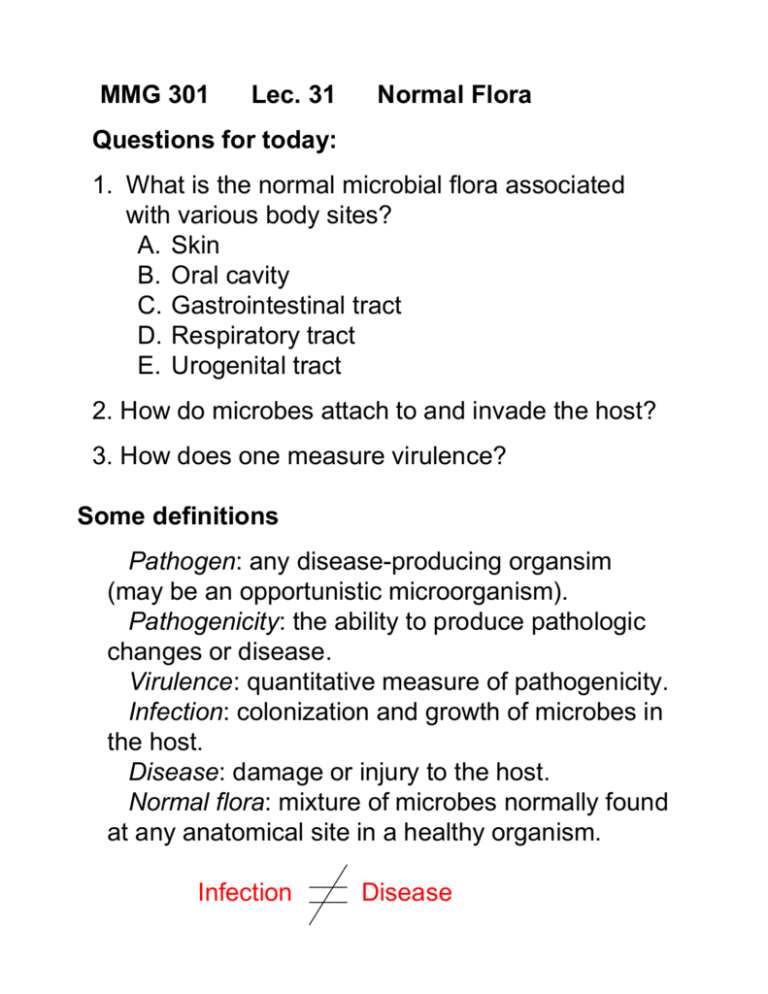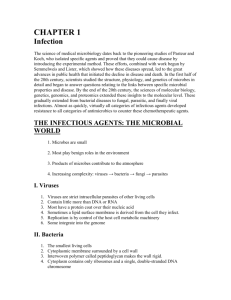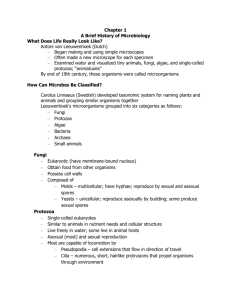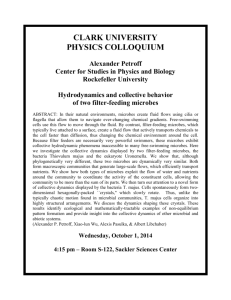MMG 301 Lec. 31 Normal Flora Questions for today: 1. What is the
advertisement

MMG 301 Lec. 31 Normal Flora Questions for today: 1. What is the normal microbial flora associated with various body sites? A. Skin B. Oral cavity C. Gastrointestinal tract D. Respiratory tract E. Urogenital tract 2. How do microbes attach to and invade the host? 3. How does one measure virulence? Some definitions Pathogen: any disease-producing organsim (may be an opportunistic microorganism). Pathogenicity: the ability to produce pathologic changes or disease. Virulence: quantitative measure of pathogenicity. Infection: colonization and growth of microbes in the host. Disease: damage or injury to the host. Normal flora: mixture of microbes normally found at any anatomical site in a healthy organism. Infection Disease Can an animal be free of microorganisms? Gnotobiotic literally means”known life”, but is typically used to mean germ free. Gnotobiotic animals: For mammals, the babies are removed from the germ-free womb using microbiologically sterile methods. For birds, care is taken to sterilize the exterior of the egg. Can establish colonies of germ-free animals that are reared in a germ-free environment. Characteristics of gnotobiotic animals: • Abnormal anatomical and physiological features • Underdeveloped lymphatic tissue • Thin intestinal wall • Low antibody titer • Higher susceptibility to pathogens • Reduced susceptibility to certain disease processes dependent on microbes • No dental caries Animals provide a wide variety of environments for microorganisms to grow Dry and wet areas Aerobic and anaerobic Neutral and high pH Important concepts: • Most of the time, normal flora protect the host from colonization by pathogenic microorganisms (“bacterial interference”) • lactobacilli in female genital tract • corynebacteria on the skin • many normal microbes can become pathogenic, especially in a compromised host (a host with a lowered resistance to infection; e.g., burn patients) • most common sites for colonization: mucous membranes (mouth, respiratory, urinary and gastrointestinal tracts) •lined with layer(s) of epithelial cells •coated with layer of mucus •types of interactions: •loose association •adhesion •invasion Normal flora: skin • largest organ – 2 m2 of area • unfavorable habitat for microorganisms – • has many areas subject to periodic drying • acidic pH • high sodium chloride concentration • most skin microbes are associated with glands • eccrine glands—dispersed sweat glands • apocrine glands—sweat glands activated during puberty (underarm, genital area, etc.) • sebaceous glands—with each hair follicle •gland secretions contain water, amino acids, urea, salts, and fatty acids that can serve as nutrients •Staphylococcus epidermidis- found in regions of high moisture •Propionibacterium acnes – normal inhabitant but is associated with the disease acne vulgaris •organism thrives in sebum produced by oil glands •growth of bacteria triggers inflamation Normal flora: oral cavity Source of nutrients for microbes is mainly ingested food • Saliva = mostly salts with some proteins (enzymes, mucoproteins, and others) • lactoperoxidase – uses hydrogen peroxide to make singlet oxygen, a natural antibiotic • lysozyme – cleaves peptidoglycan and kills bacteria • colonization of the tooth surface (very complex) • begins as layer of glycoprotein on surface of clean tooth • attachment and colonization by several strains of Streptococcus • continued growth results in thick layer called plaque • More strains colonize the biofilm (Fusobacteria, Actinomycetes, even spirochetes) Major oral diseases of microbial origin •dental caries – colonization of tooth crevices by microorganisms followed by demineralization of tooth surface (sugar fermentation to lactic acid) •Streptococcus mutans – major organism •adheres to tooth surface with aid of dextran (a polymer of glucose): aids in formation of biofilm [sucrose = disaccharide of glucose+fructose, sucrase is used to transfer glucose onto the dextran chain while releasing fructose – used for growth] •Porphyromonas gingivalis – responsible for gingivitis: attachment to biofilms aided by fimbriae Normal flora: gastrointestinal tract Stomach is major barrier – pH 2 kills most microbes Interesting exception = Helicobacter pylori This microbe has urease; hydrolyzes urea (diffusing in from the blood) which results in an increase in pH (i.e., a buffered zone around the cells) allowing colonization. After attaching to the stomach lining, this pathogen releases various enzymes leading to ulcers. Duodenum/jejunum are pretty sterile Ileum – 105-107 cells/gram Large intestine – bacterial fermentation chamber • facultative anaerobes – such as E. coli consume any oxygen that is present; ~107 cells/g. Thus large intestine is mainly anaerobic • anaerobes – 1010 – 1011 cells/g; mostly Bacteroides, Clostridium, Entercoccus; many live attached to intestinal wall • beneficial effects of intestinal microbes: vitamin synthesis: B12, pyridoxine, thiamin, K glycosidase activity: lots of sugar fermenters steroid metabolism: bile acids are converted to steroids that are reabsorbed Flatus (gas) = hydrogen, carbon dioxide, methane (in about 1/3 of us). Odor from sulfide, amines, skatole, butyric acid. Time for food to pass through ~ 24 h Colon bacteria exhibit 1-2 doublings/day (constant loss mimics chemostat-like behavior) Antibiotics can kill pathogens and the healthy microbes, leading to gastric distress until the beneficial strains become reestablished. Normal flora: respiratory tract • modes of protection: • continuous stream of flowing mucus produced by ciliated cells • phagocytic action of macrophages • production of lysozyme in mucus Major sections of the respiratory tract: • Upper: nasopharynx, oral cavity, throat – this is colonized by a wide assortment of microorganisms (streptococci, staphylococci, Gram-negative cocci) including pathogens (Staphylococcus aureus, Streptococcus pyrogenes, S. pheumoniae, Corynebacterium diphtheriae) • Lower: trachea, lungs – nearly sterile Normal flora: urogenital tract Bladder is usually sterile, but urethra has E. coli, Proteus mirabilis, etc. Infection with bacterium possessing urease leads to a pH increase and salt precipitation; ~25% of “stones” are from infection. The microbiology of the vagina is especially interesting: - pre-puberty: no glycogen is synthesized in vagina, so not available as bacterial nutrition source. High pH - after puberty: glycogen is used by microbes as food, fermented to lactic acid (especially, Lactobacillus acidophilus) and pH is acidic. - after menopause: returns to the glycogen-free, alkaline environment lacking lactic acid bacteria. Attachment and invasion of the host Several events lead to the invasion of the host by a pathogenic microorganism • Adherence – attachment of the microbe to host cell surfaces • Invasion – penetration through the epithelium and entry into deeper tissues • Colonization and growth Adherence: many bacteria exhibit host and tissue specificity • Fimbriae and pili – filamentous structures that aid attachment •Neisseria gonorrhoeae – attachment to urogenital epithelium aided by pili •E. coli – fimbriae; “Type I” fimbriae most common in urogenital infectious bacteria such as Escherichia, Klebsiella, Salmonella, Shigella Alternative modes of adherence include use of lipoteichoic acids or use of slime, capsule, or glycocalyx components. Thus, protein:protein, protein:sugar, and other types of interactions play a role in adherence. Invasion: modes for entry into host tissues and cells: •Production of lytic substances that: •Attack the basement membranes of integuments and intestinal linings •Degrade carbohydrate-protein complexes that glue host cells together •Disrupt the cell surface •Passive entry through lesions, ulcers, wounds, bites, etc. Colonization: growth may be hindered by lack of nutrients. For example, the host binds up all Fe so that special mechanisms are needed for the pathogen to obtain this micronutrient. Growth may be - only at the site of infection (boils, carbuncle, pimple) - localized to the lymph nodes - carried throughout the bloodstream (systemic infection). Large numbers of microbes in the blood is known as bacteremia. Measuring virulence LD50 The virulence of a pathogen often is attenuated (reduced) as the culture is grown in the lab. [Attenuated cultures are used for vaccines] Another component of virulence is invasiveness. For example, Streptococcus pneumoniae is highly invasive because its capsule allows it to evade phagocytosis. [e.g., Jim Henson (Muppet creater) died in 1990 after 3 day infection]








